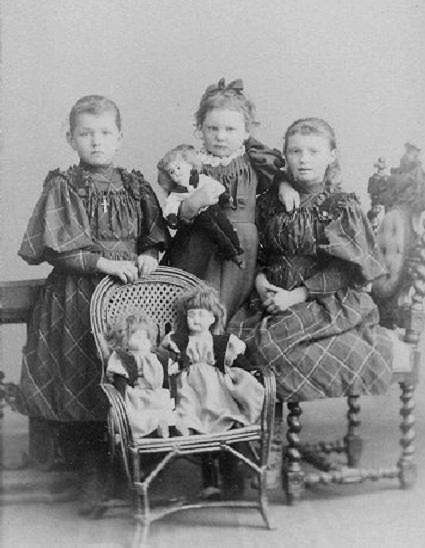
Coordinated Family Outfits: Twins

Figure 1.--HBC has no information about who these childrn. The image is almost certainly American. HBC estimates that the photograph was probably taken in the 1880s. The two older sisters appear to be fraternal twins. Click on the image for an assessment of the outfits.
|
Twins most commonly have been dressed alike. HBC believes that in the 19th century that it was quite common to dress twins in identical outfits. Many parents still like to dress their younger twins in identical outfits, but now less commonly do so once they have reached school age. Usually this style was for twin brothers or twin sisters. However, in many cases fraternal brother and sister twins were dressed alike. This appears to have been a popular fashion dating back to earliest available photographic images. Dressing twins alike is still a common fashion today, although sometimes as they get older they like to dress differently. One important factor was what kind of twins they were, identical or fraternal.
Types
There are two basic kinds of twins, although other types are theoretically possible.
Identical twins are genetically identical, having developed from a single fertizied egg. Identical twins (monozygotic) result when a single fertilized egg splits after conception. The resulting twins are the same sex and genetically alike, with similar foot and hand prints, but different fingerprints and teeth marks. The egg then splits into two genetically identical halves. They share 100 percent of their genes. Differences can devekoped based on diet, life experiences, enviroment and other factors. There can be differences such as variation in freckle patterns. Studies have shown that even twins raised apart exhibit remarkable similarity. As a result, identical twins have to be either brothers or sisters, but not one of each mixed genders.
Franternal twins are brothers and sisters conceived at the same time, but as a result of seoarate fertilized eggs. Fraternal twins (dizygotic) result when two eggs are released by the mother at the same time and each egg is fertilized by a different sperm. Fraternal twins can be of the same or opposite sex. They share up to 50 percent of their genes, and are no more alike or different than any two siblings would be, but there bond is just as special. They may look quite alike or in some cases are very different. The fact that they have the same parents make them look alike as do many brothers and sisters born at separate times.
HBC Archives
HBC has archieved numerous photographs of twins. We hope to eventually link those images here. We note that dressing twins alike was a well established convention in the early 20th century.
One of te earliest images we have found is a portrait of the Danish Eckersberg children in the 1810s.
We note the Connat children in the 1850s. The girls look to be twins, but as with many paintings and photographs, we are not positive.
are the English Spurgeon twins in the late 1850s or early 60s.
Carl and Fritz Gulick wear identical pinafores, we think in the 1880s. The French DeLesseps family included twins. We note unidentified American fratenal twins probably in the 1890s.
We note Charles and Elizabeth Spenser in 1900.
We note English girls, Molly and Betty Blewitt during the 1920s.
We note an American birthday portrait in 1931.
Billy and Boby Mauch were popular child movie stars im the 1930s.
We note German twins in 2000 having a 1900 experience.
We have noted portraits that seem to be taken of a boy before and after breeching. Unfortunately many old photographs come without provinance. One possibility is that some of these photographs could be boy and girl fraternal twins. Unfortunately without the necessary provinance, it is impossible to tell.
Current Trends
The number of births in twin deliveries rose 6 percent for 1997-98 to 110,670 births- the largest single year rise in several decades. The number of Triplet Births climbed to 6919, a rise of 13 percent. Births in quadruplet deliveries increased from 510 to 627 between 1997 and 1998: the number of quintuplet and other higher order multiples was unchanged at 79. Since 1980 twin births have risen 62 perecent and other higher order muliptles births have jumped 470 percent. The Twin birth rate has risen 5 percent for the current year and the Triplet birth rate has risen 11 percent. Both Twin and Triplet birth rates have risen steadily since 1980, by 49 and 423 percent respectively, but the pace of the increase has quickened in the 1990's. There are now over 500,000 multiples 5 and under in the United Staes. Two related trends have been associated with the rise in multiple births, especially with the rise of higher order multiples; older age at childbearing (women in their thirties are more likely than younger women to have a multiple birth, even without the use of fertility therapy), and the more widespread use of fertility-enhancing therapies (fertility drugs and techniques such as in vitro fertilization). These therapies have been associated with the remarkable upswing in multiple births of the 1980's and 1990's. A recent study estimates that about 80 percent of triplet births in 1996 and 1997 were the result of fertility techniques. [Centers for Disease Control and Prevention]
Sources
Centers for Disease Control and Prevention. National Vital Statistics Reports (Volume 48, Number 3).
HBC

Navigate the Boys' Historical Clothing Web Site:
[Retirn to the Main family outfit page]
[Introduction]
[Activities]
[Biographies]
[Chronology]
[Clothing styles]
[Countries]
[Fashion images]
[Bibliographies]
[Contributions]
[FAQs]
[Glossaries]
[Satellite sites]
[Boys' Clothing Home]
Created: September 12, 2000
Last updated: 8:57 PM 12/7/2005



